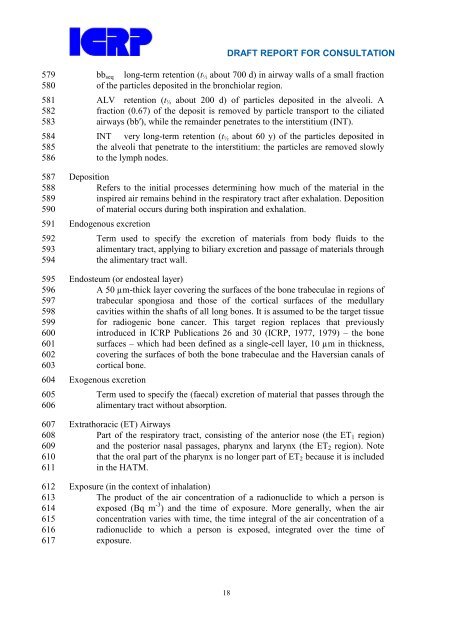Occupational Intakes of Radionuclides Part 1 - ICRP
Occupational Intakes of Radionuclides Part 1 - ICRP
Occupational Intakes of Radionuclides Part 1 - ICRP
Create successful ePaper yourself
Turn your PDF publications into a flip-book with our unique Google optimized e-Paper software.
579<br />
580<br />
581<br />
582<br />
583<br />
584<br />
585<br />
586<br />
587<br />
588<br />
589<br />
590<br />
591<br />
592<br />
593<br />
594<br />
595<br />
596<br />
597<br />
598<br />
599<br />
600<br />
601<br />
602<br />
603<br />
604<br />
605<br />
606<br />
607<br />
608<br />
609<br />
610<br />
611<br />
612<br />
613<br />
614<br />
615<br />
616<br />
617<br />
DRAFT REPORT FOR CONSULTATION<br />
bbseq long-term retention (t½ about 700 d) in airway walls <strong>of</strong> a small fraction<br />
<strong>of</strong> the particles deposited in the bronchiolar region.<br />
ALV retention (t½ about 200 d) <strong>of</strong> particles deposited in the alveoli. A<br />
fraction (0.67) <strong>of</strong> the deposit is removed by particle transport to the ciliated<br />
airways (bb′), while the remainder penetrates to the interstitium (INT).<br />
INT very long-term retention (t½ about 60 y) <strong>of</strong> the particles deposited in<br />
the alveoli that penetrate to the interstitium: the particles are removed slowly<br />
to the lymph nodes.<br />
Deposition<br />
Refers to the initial processes determining how much <strong>of</strong> the material in the<br />
inspired air remains behind in the respiratory tract after exhalation. Deposition<br />
<strong>of</strong> material occurs during both inspiration and exhalation.<br />
Endogenous excretion<br />
Term used to specify the excretion <strong>of</strong> materials from body fluids to the<br />
alimentary tract, applying to biliary excretion and passage <strong>of</strong> materials through<br />
the alimentary tract wall.<br />
Endosteum (or endosteal layer)<br />
A 50 µm-thick layer covering the surfaces <strong>of</strong> the bone trabeculae in regions <strong>of</strong><br />
trabecular spongiosa and those <strong>of</strong> the cortical surfaces <strong>of</strong> the medullary<br />
cavities within the shafts <strong>of</strong> all long bones. It is assumed to be the target tissue<br />
for radiogenic bone cancer. This target region replaces that previously<br />
introduced in <strong>ICRP</strong> Publications 26 and 30 (<strong>ICRP</strong>, 1977, 1979) – the bone<br />
surfaces – which had been defined as a single-cell layer, 10 µm in thickness,<br />
covering the surfaces <strong>of</strong> both the bone trabeculae and the Haversian canals <strong>of</strong><br />
cortical bone.<br />
Exogenous excretion<br />
Term used to specify the (faecal) excretion <strong>of</strong> material that passes through the<br />
alimentary tract without absorption.<br />
Extrathoracic (ET) Airways<br />
<strong>Part</strong> <strong>of</strong> the respiratory tract, consisting <strong>of</strong> the anterior nose (the ET1 region)<br />
and the posterior nasal passages, pharynx and larynx (the ET2 region). Note<br />
that the oral part <strong>of</strong> the pharynx is no longer part <strong>of</strong> ET2 because it is included<br />
in the HATM.<br />
Exposure (in the context <strong>of</strong> inhalation)<br />
The product <strong>of</strong> the air concentration <strong>of</strong> a radionuclide to which a person is<br />
exposed (Bq m -3 ) and the time <strong>of</strong> exposure. More generally, when the air<br />
concentration varies with time, the time integral <strong>of</strong> the air concentration <strong>of</strong> a<br />
radionuclide to which a person is exposed, integrated over the time <strong>of</strong><br />
exposure.<br />
18

















